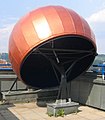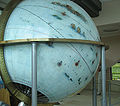Hollow globe
Hollow globes are the forerunners of modern projection planetariums . It is a large, walkable sphere, on the inside of which either the constellations were drawn or in the shell of which there were holes through which light penetrated from the outside. The larger the hole, the brighter the “star” associated with the hole shone.
In contrast to static ceiling paintings of the starry sky, the view of the sky at different times of the year can be simulated with a hollow globe, since the sphere can be rotated and the southern stars can rise and set, while the stars near the north celestial pole never set ( circumpolar stars ).
There were never very many of these hollow globes. Currently only four are known worldwide:
- The original Gottorf giant globe is now in the Kunstkammer in Saint Petersburg and was commissioned by Duke Friedrich III between 1650 and 1664 . erected by Gottorf . It is also known as the Gottorper Globus .
- The Atwood celestial sphere originally stood in the Chicago Natural History Museum, now it is in the Adler Planetarium . It was commissioned in 1913.
- Around 1914/1915, a two-meter-diameter rotating hollow globe was erected at the Robert Mayer Observatory in Heilbronn , which is still in operation today as part of public tours and school events.
- At the beginning of the 21st century, the original Gottorf giant globe was reconstructed in a modern building in Gottorf Castle .
A hollow globe by Erhard Weigel from Jena with a diameter of 3.30 meters and one with a diameter of 5.40 meters, which goes back to Roger Long from Cambridge in England, are known from the 18th century - but both devices were destroyed or scrapped.
Web links
Individual evidence
- ↑ The rotating hollow globe ( Memento of the original from December 29, 2008 in the Internet Archive ) Info: The archive link was inserted automatically and has not yet been checked. Please check the original and archive link according to the instructions and then remove this notice.
- ↑ Hollow world made of sheet metal. In: Astronomy Today , October 2005


